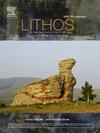Garnet and clinopyroxene from 1.98 Ga Kimozero kimberlites, Karelia, Russia: Evidence of the multistage evolution of the ancient lithospheric mantle
IF 2.9
2区 地球科学
Q2 GEOCHEMISTRY & GEOPHYSICS
引用次数: 0
Abstract
We present the major and trace element data for garnets and clinopyroxenes from the heavy mineral concentrate of the 1.98 Ga Kimozero kimberlites, Karelia, Russia, in the context of mantle petrology and evolution.
All studied garnets are characterized by high-Cr-Ca compositions with CaO and Cr2O3 contents up to 13 wt% and classified as garnets from the wehrlite paragenesis. The uvarovite content could reach up to 0.29 mol%. Kimozero garnets are characterized by low TiO2 concentrations and highly enriched in light rare earth elements, distinguishing them from the classical garnet from peridotite xenoliths and megacrysts from Phanerozoic kimberlites.
Based on the variations in garnet composition, we suggest that at 1.98 Ga, the lithospheric mantle of the Karelian craton underwent several tectonothermal events. The high Cr2O3 compositions of the studied garnets we propose that the protolith of the Kimozero garnets was a highly depleted high-Mg# high-Cr mantle substrate that underwent extensive melting in the spinel-garnet stability region and that the Cr-rich garnet has a spinel precursor. The high CaO content and elevated LREE and HFSE concentrations indicate that the Kimozero garnets suggested multiple stages of mantle metasomatism. Garnets with high CaO and Cr2O3 composition and weakly sinusoidal REE patterns with low Zr/Hf and La/Yb ratios and high Ti/Eu ratios suggested water-rich carbonate fluid as the agent of mantle metasomatism. An increasing the Zr/Hf and La/Yb ratios with low Ti/Eu and significant LREE enrichment in some Kimozero garnets indicates an increasing role of carbonate fluid in the metasomatic processes. Enrichment in the HREE and Zr concentrations, along with decreasing CaO and Cr2O3 in garnet, may reflect an additional stage of mantle metasomatism associated with early stages of mantle plume ascent.
Clinopyroxene xenocrysts are predominantly Cr-diopsides with Mg# values ranging 0.85–0.92 with Cr2O3 (1.32–4.03 wt%) and Na2O (1.67–2.81 wt%) concentrations, low TiO2 contents and enrichment in light rare earth elements (Ce![]() Nd) compared to heavy rare earth elements. Such clinopyroxenes could be formed by a metasomatic process, specifically the interaction of melts that have equilibrated to MARID-type mantle metasomatites with the depleted lithospheric mantle.
Nd) compared to heavy rare earth elements. Such clinopyroxenes could be formed by a metasomatic process, specifically the interaction of melts that have equilibrated to MARID-type mantle metasomatites with the depleted lithospheric mantle.
The mineralogy of xenocrysts from the Kimozero kimberlite differs from the widespread xenogenic mantle mineralogy of the Neoproterozoic and Phanerozoic kimberlites. The high-Cr and low-Ti contents of the garnets and clinopyroxenes and the presence of uvarovite garnets could be the characteristics of the ancient lithospheric mantle, which was not preserved until the Phanerozoic due to the cooling of the Earth, and numerous plume and metasomatic events that perturbed the subcontinental lithospheric mantle.
求助全文
约1分钟内获得全文
求助全文
来源期刊

Lithos
地学-地球化学与地球物理
CiteScore
6.80
自引率
11.40%
发文量
286
审稿时长
3.5 months
期刊介绍:
Lithos publishes original research papers on the petrology, geochemistry and petrogenesis of igneous and metamorphic rocks. Papers on mineralogy/mineral physics related to petrology and petrogenetic problems are also welcomed.
 求助内容:
求助内容: 应助结果提醒方式:
应助结果提醒方式:


